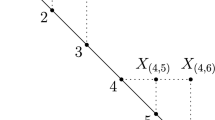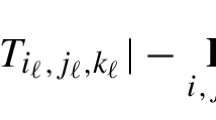Abstract
In signal processing, the detection error probability of a random quantity is a fundamental and often difficult problem. In this work, we assume that we observe under the alternative hypothesis a noisy tensor admitting a Tucker decomposition parametrized by a set of orthonormal factor matrices and a random core tensor of interest with fixed multilinear ranks. The detection of the random entries of the core tensor is hard to study since an analytic expression of the error probability is not tractable. To cope with this difficulty, the Chernoff Upper Bound (CUB) on the error probability is studied for this tensor-based detection problem. The tightest CUB is obtained for the minimal error exponent value, denoted by \(s^\star \), that requires a costly numerical optimization algorithm. An alternative strategy to upper bound the error probability is to consider the Bhattacharyya Upper Bound (BUB) by prescribing \(s^\star =1/2\). In this case, the costly numerical optimization step is avoided but no guarantee exists on the tightness optimality of the BUB. In this work, a simple analytical expression of \(s^\star \) is provided with respect to the Signal to Noise Ratio (SNR). Associated to a compact expression of the CUB, an easily tractable expression of the tightest CUB is provided and studied. A main conclusion of this work is that the BUB is the tightest bound at low SNRs but this property is no longer true at higher SNRs.
Frank Nielsen—This research was partially supported by Labex DigiCosme (project ANR-11-LABEX-0045-DIGICOSME) operated by ANR as part of the program “Investissement d’Avenir” Idex Paris-Saclay (ANR-11-IDEX-0003-02).
Access this chapter
Tax calculation will be finalised at checkout
Purchases are for personal use only
Similar content being viewed by others
References
Comon, P.: Tensors: A brief introduction. IEEE Signal Process. Mag. 31(3), 44–53 (2014)
Cichocki, A., Mandic, D., De Lathauwer, L., Zhou, G., Zhao, Q., Caiafa, C., Phan, H.A.: Tensor decompositions for signal processing applications: From two-way to multiway component analysis. IEEE Signal Process. Mag. 32(2), 145–163 (2015)
Chang, K., Qi, L., Zhang, T.: A survey on the spectral theory of nonnegative tensors. Numer. Linear Algebra Appl. 20(6), 891–912 (2013)
Tucker, L.R.: Some mathematical notes on three-mode factor analysis. Psychometrika 31(3), 279–311 (1966)
De Lathauwer, L., De Moor, B., Vandewalle, J.: A multilinear singular value decomposition. SIAM J. Matrix Anal. Appl. 21(4), 1253–1278 (2000)
Bro, R.: PARAFAC: Tutorial and applications. Chemometr. Intell. Lab. Syst. 38(2), 149–171 (1997)
Badeau, R., Boyer, R.: Fast multilinear singular value decomposition for structured tensors. SIAM J. Matrix Anal. Appl. 30(3), 1008–1021 (2008)
Boyer, R., Badeau, R.: Adaptive multilinear SVD for structured tensors. In: IEEE International Conference on Acoustics Speech and Signal Processing Proceedings, vol. 3. IEEE (2006) III-III
Boizard, M., Ginolhac, G., Pascal, F., Forster, P.: Low-rank filter and detector for multidimensional data based on an alternative unfolding HOSVD: application to polarimetric STAP. EURASIP J. Adv. Signal Process. 2014(1), 1–14 (2014)
Kay, S.M.: Fundamentals of Statistical Signal Processing: Estimation Theory. PTR Prentice-Hall, Englewood Cliffs (1993)
Nielsen, F., Bhatia, R.: Matrix Information Geometry. Springer, Heidelberg (2013)
Cover, T.M., Thomas, J.A.: Elements of Information Theory. Wiley, New York (2012)
Boyer, R., Nielsen, F.: Information geometry metric for random signal detection in large random sensing systems. In: ICASSP (2017)
Author information
Authors and Affiliations
Corresponding author
Editor information
Editors and Affiliations
Rights and permissions
Copyright information
© 2017 Springer International Publishing AG
About this paper
Cite this paper
Boyer, R., Nielsen, F. (2017). On the Error Exponent of a Random Tensor with Orthonormal Factor Matrices. In: Nielsen, F., Barbaresco, F. (eds) Geometric Science of Information. GSI 2017. Lecture Notes in Computer Science(), vol 10589. Springer, Cham. https://doi.org/10.1007/978-3-319-68445-1_76
Download citation
DOI: https://doi.org/10.1007/978-3-319-68445-1_76
Published:
Publisher Name: Springer, Cham
Print ISBN: 978-3-319-68444-4
Online ISBN: 978-3-319-68445-1
eBook Packages: Computer ScienceComputer Science (R0)




